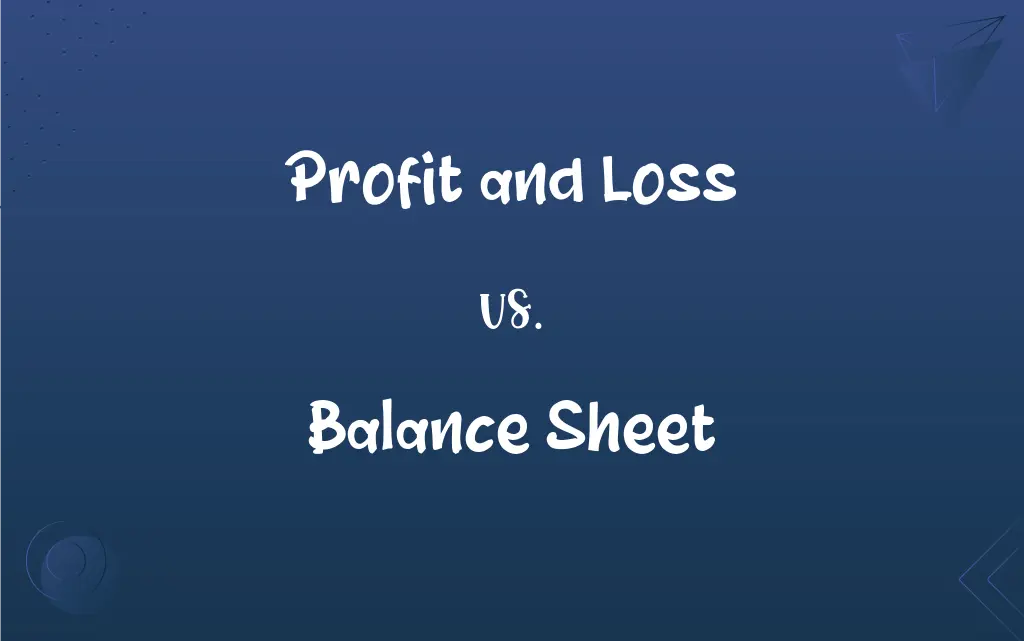Profit and Loss vs. Balance Sheet: What's the Difference?
Edited by Janet White || By Harlon Moss || Updated on October 10, 2023
Profit and Loss (P&L) shows company's revenues and expenses over a period, while a Balance Sheet displays company's assets, liabilities, and equity at a single point in time.

Key Differences
The Profit and Loss statement, commonly known as the income statement, plays a crucial role in illustrating a company's financial health by depicting its revenue, expenses, and net income or loss over a specific time frame. It succinctly outlines whether a company is generating a profit or incurring a loss by subtracting total expenses from total revenues. The top line of a P&L statement begins with the total revenue (or sales), and as one moves down, various expenses, taxes, and other deductions are subtracted, resulting in net income or loss at the bottom.
Conversely, a Balance Sheet provides a snapshot of a company's financial condition at a particular moment, not over a period like the P&L. It details what a company owns (assets), owes (liabilities), and the amount invested by shareholders (equity). The fundamental equation underlying a balance sheet is: Assets = Liabilities + Equity. This equation demonstrates that assets, financed by liabilities or equity, should balance out, ensuring the financial report's integrity.
In the world of accounting and finance, the Profit and Loss statement is pivotal for investors and stakeholders to comprehend how well a company is performing in terms of its operational activities and profitability. It emphasizes revenues, costs, and expenses, crucial factors for determining the operational efficiency and fiscal health of a business. Various stakeholders, including investors, creditors, and executive management, utilize P&L to make informed decisions.
The Balance Sheet, while offering a different form of insight, affords stakeholders a wider view of a company’s financials, revealing its general financial structure and the ability to meet its obligations. The balance sheet’s crucial role in depicting a company's liquidity and solvency makes it an indispensable tool for stakeholders to analyze the firm's ability to continue operations and meet its obligations without running into severe financial trouble.
Understanding both Profit and Loss and Balance Sheet is vital for comprehensively analyzing a company’s financial position and performance. While the P&L gives insights into the profitability and operational activities of a firm, the balance sheet allows stakeholders to scrutinize the company's financial stability by examining its assets, liabilities, and equity, thus providing complementary views and collectively offering a holistic picture of a company’s financial health.
ADVERTISEMENT
Comparison Chart
Definition
A financial statement showing revenue and expense
A statement displaying assets, liabilities, and equity
Time Frame
Covers a specific period (e.g., a month, quarter, year)
A snapshot at a specific date
Primary Components
Revenues, expenses, and net profit/loss
Assets, liabilities, and shareholder's equity
Purpose
To ascertain profitability
To depict financial position
Effect of Transactions
Transactions affect period’s income & expenses
Transactions alter asset, liability, or equity status
ADVERTISEMENT
Profit and Loss and Balance Sheet Definitions
Profit and Loss
It reflects a company's ability to generate profit by minimizing costs.
Despite substantial revenues, the Profit and Loss statement highlighted alarming operational costs.
Balance Sheet
The balance sheet is pivotal for assessing a company’s liquidity and solvency.
Stakeholders often scrutinize the balance sheet to gauge the firm's capability to meet short-term obligations.
Profit and Loss
Profit and Loss summarizes a company's revenues and expenses.
The Profit and Loss statement revealed a surprising deficit in the last quarter.
Balance Sheet
Balance sheet provides insights into the company's financial positioning to stakeholders.
The declining assets visible on the balance sheet raised concerns among the company’s investors.
Profit and Loss
It’s a financial document showcasing net income or net loss.
The startup’s first Profit and Loss statement showcased an impressive net income.
Balance Sheet
A balance sheet illustrates a company’s financial status at a specific point in time.
The balance sheet revealed that the company’s liabilities have noticeably increased this year.
Profit and Loss
P&L is essential for analyzing the financial performance of a company.
The annual Profit and Loss statement became a focal point during the shareholder's meeting.
Balance Sheet
It's a financial document detailing assets, liabilities, and shareholder equity.
According to the balance sheet, the company’s assets surpassed its liabilities, indicating stability.
Profit and Loss
P&L displays operational profits by deducting expenses from revenues.
Healthy revenues on the Profit and Loss didn’t necessarily translate into high net profit due to high costs.
Balance Sheet
It ensures that a company’s finances are in balance using the equation: Assets = Liabilities + Equity.
Discrepancies in the balance sheet can indicate errors or fraudulent activities in financial reporting.
FAQs
How often are Profit and Loss statements generated?
Typically monthly, quarterly, and annually, but can be generated as needed.
What is a Profit and Loss statement?
A document detailing a company’s revenues, expenses, and profits or losses over a specific period.
What is the key equation for a Balance Sheet?
Assets = Liabilities + Shareholder’s Equity.
What do assets on a Balance Sheet represent?
Assets represent items of value that a company owns or controls.
Is the Profit and Loss statement the same as the Income Statement?
Yes, the terms are often used interchangeably in financial reporting.
Who uses the Profit and Loss statement?
Business owners, investors, financial analysts, and various stakeholders to gauge a company's financial performance.
What is net income in a Profit and Loss statement?
It is the total profit of the company after deducting all expenses from the revenue.
Why do companies need to prepare a Balance Sheet?
To provide a clear picture of the company's financial status to stakeholders and comply with regulatory requirements.
How does a Profit and Loss statement deal with debts?
Debts (interest expenses) are usually listed as an expense, reducing the overall profit.
What do equity figures on a Balance Sheet indicate?
Equity figures indicate the owner's or shareholder’s financial interest in the company.
Why is the Balance Sheet important?
It provides a snapshot of a company's financial position, showing assets, liabilities, and equity at a particular point in time.
Can a Profit and Loss statement indicate company health?
Yes, it reveals the profitability and could indicate the financial health of a company.
What is the difference between revenue and profit in P&L?
Revenue is total income, while profit is the income remaining after deducting all expenses.
Can liabilities on a Balance Sheet be beneficial for a company?
Yes, strategically acquired liabilities like loans can be used for beneficial investments or managing cash flow.
Can a Balance Sheet help in financial planning?
Yes, it provides valuable insights into assets and liabilities, essential for strategic financial planning.
What is gross profit in the Profit and Loss statement?
Gross profit is the profit a company makes after deducting the costs associated with making and selling its products.
Are assets on a Balance Sheet always physical items?
No, assets can be physical (tangible) or non-physical (intangible) like patents or trademarks.
How do assets and liabilities affect a company’s Balance Sheet?
The Balance Sheet must balance by following the equation: Assets = Liabilities + Equity, affecting financial planning and analysis.
Is the Balance Sheet useful for investors?
Yes, it helps investors understand a company’s financial stability and risk levels.
What role do expenses play in a Profit and Loss statement?
Expenses reduce total revenue, and controlling them effectively is vital for enhancing profitability.
About Author
Written by
Harlon MossHarlon is a seasoned quality moderator and accomplished content writer for Difference Wiki. An alumnus of the prestigious University of California, he earned his degree in Computer Science. Leveraging his academic background, Harlon brings a meticulous and informed perspective to his work, ensuring content accuracy and excellence.
Edited by
Janet WhiteJanet White has been an esteemed writer and blogger for Difference Wiki. Holding a Master's degree in Science and Medical Journalism from the prestigious Boston University, she has consistently demonstrated her expertise and passion for her field. When she's not immersed in her work, Janet relishes her time exercising, delving into a good book, and cherishing moments with friends and family.































































